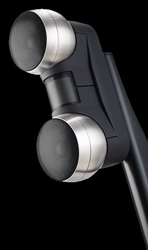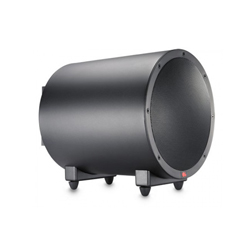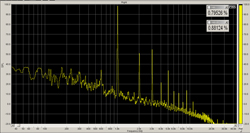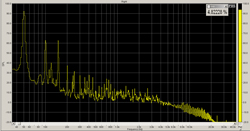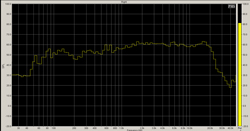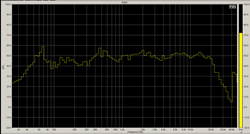Introduction to the Gallo Strada 2 Speakers and TR-3D Subwoofers
If you’ve read any of my reviews before, you know I am a fan of Anthony Gallo Acoustics loudspeakers. I reviewed the original Strada loudspeaker and TR-3 subwoofer in 2010 and was so impressed I almost bought them. The only reason I didn’t was because I knew the Reference 3.5 was coming. Those? I bought those, and they are still my reference loudspeaker (however, the 3.5 will be discontinued soon). Gallo claims the new Strada 2 loudspeakers are even better than the original Strada, and the TR-3D is an improvement over then TR3. Both new speakers use almost identical technology to that of the Reference 3.5. Another salvo by Gallo has leveled the paying field between the new Strada 2 and the Reference 3.5s even more. The price of the Strada 2 and TR-3D is identical to the earlier models. The complete system cost with stands weighs in at $4,417 (which includes two TR-3D subs). This used to be a lot cheaper than the $5,995 Reference 3.5. Gallo recently reduced the price of the Reference 3.5 to $3,995, plus an additional $749 for the amp. Now, the price of the two systems is almost identical, within less than $400. The question is, which is better? We will see.
GALLO STRADA 2 SPEAKERS AND TR-3D SUBWOOFERS SPECIFICATIONS
Strada 2 Speakers
- Design: One-way, Sealed Enclosure, Powder-coated Cast Aluminum, Brushed Stainless Steel
- Drivers: One Cylindrical Diaphragm Tweeter, Two 4″ Carbon Fiber
- MFR: 68 Hz – 20 kHz ± 3 dB (In Room with Boundary Reinforcement, Speakers within 1′ of Wall)
- Nominal Impedance: 8 Ohms
- Sensitivity: 90dB/1 Watt/1 Meter
- Power Handling: 150 Watts RMS. Minimum Suggested Power: 10 Watts RMS
- Connections: 5-way Gold-plated Speaker Binding Posts
- Dimensions: 5″ H x 13″ W x 6.5″ D
- Weight: 13.5 Pounds/each
- Price: $1,998/pair USD, $450/pair for Optional Stands
TR-3D Subwoofer
- Design: Powered Subwoofer, Sealed Enclosure
- Driver: 10″ Anodized Aluminum
- Amplifier Power: 300 Watts RMS, Class D
- MFR: 18 Hz – 180 Hz ± 3 dB
- Connections: Two RCA In, Two RCA Out, Five-way Speaker Binding Posts
- Phase 0/180 Switch
- Low Pass: 50 to 180Hz, Continuously Variable with LFE By-pass Switch
- Bass EQ: 0, +3dB, +6dB, 30Hz Center Frequency
- Dimensions: 12″ H x 10.75″ W x 13.5″ D
- Weight: 33 Pounds
- MSRP: $984.50 USD
- Anthony Gallo
- SECRETS Tags: Gallo, Speakers, Audio
Design and Setup of the Gallo Strada 2 Speakers and TR-3D Subwoofers
If you don’t look very closely, you could very easily mistake the new Strada 2 and TR-3D for their predecessors. You’d be forgiven, because they really do look identical from the outside. All the improvements to the speakers are internal. The Strada 2 is essentially the midrange and tweeter unit from the floorstanding Reference 3.5s, my current reference speaker. They consist of a pair of spherical stainless steel midrange enclosures with 4″ carbon fiber cone drivers, and Gallo’s patented CDT3 cylindrical diaphragm tweeter. This tweeter is the third iteration of the driver that launched Anthony Gallo Acoustics speakers many years ago. The tweeter has a very wide lateral dispersion pattern, and wide frequency response from 6 kHz to past 20 kHz. The midrange pods are now filled with Gallo’s S2 internal damping, a proprietary fiber filling that increases the mass loading of the driver. As with most all other Gallo speakers, there is no electronic crossover between the midrange and tweeter. The acoustic properties of the drivers and enclosures provide the crossover. The pods weigh a hefty 13.5 lbs each, given their small size. These pods can be either stand or wall mounted. Separate floor stands are available for $450. I consider these essential for realizing the remarkable imaging and soundstaging the speakers are capable of. The stands are entirely cast aluminum, powder coated black. They are unusually tall, placing the tweeter axis 37″ above the floor. This can be a challenge for home theater setups. In my room, the speakers partially block the view from seating off to the sides of the screen when placed well out in the room for best sound quality. I placed them in the same location I keep the Reference 3.5s, but the Strada 2s are a good foot taller on their stands. I don’t believe this will be an issue for most people, but realize the speakers with stands are quite tall.
The TR-3D subwoofer also looks identical to the earlier TR3. The new speaker has the same dual voice coil ceramic cone driver as the Reference 3.5. In addition, the 300W Class AB power amplifier of the TR3 has been replaced with a new 300W Class D digital amplifier. The controls and connections on the rear panel remain the same: RCA and speaker level inputs, and RCA outputs (both pass through and with a 100 Hz high pass filter). The low pass crossover is continuously variable from 50 to 180 Hz, as is the gain. Phase is switchable from 0 to 180 degrees, and a 30 Hz bass boost is selectable at 0, +3 dB and +6 dB. These are similar controls to that on the Reference SA subwoofer amp I use to drive the second voice coil of the Reference 3.5s. The Ref SA adds continuously adjustable phase and continuously adjustable bass boost settings to that of the TR-3D, but has considerably less power. The TR-3D is spec’d to reach 18 Hz on the low end, 4 Hz lower than the earlier model, and 2 Hz lower than the Reference 3.5 with active bass.
In the last test of the Strada and TR3, the bass was the one place my older Reference 3.1s won the battle. To make the playing field more level, this time I asked Gallo to send me a pair of TR-3Ds, allowing me to set up full stereo bass. I placed the Strada 2s well out into the room in the same location as I had the Reference 3.5s, toed in toward the listener about half way between straight ahead and pointing right at me. I put the TR-3Ds just inboard of the Strada 2s firing forward. I set the crossover and gain by ear for listening tests before doing any measurements.
The Gallo Strada 2 Speakers and TR-3D Subwoofers In Use
My initial impression of the Strada 2 system was how similar it sounded to my Reference 3.5s. You might expect this, as the speakers use almost identical components, but it’s certainly worth checking. The soundstage remained as impressively wide and deep as with the 3.5s, but was considerably taller. This is almost certainly due to the tall stands the speakers are mounted on. While undeniably impressive, I found the soundstage to be a bit too tall, bordering on unnatural. With well-recorded material, the soundstage reached up towards the ceiling of the room. Many people will probably like this, but I would prefer the stands to be a bit lower, maybe 3″-6″. As with the 3.5s, the speed, clarity and accuracy of timbre were excellent, certainly for any speaker near their respective price points. Probably due to the lack of a normal cabinet, the speed and agility of the Strada 2s compete with electrostatic speakers with none of their inherent drawbacks. All this leads to a spectacular ability to extract detail from recordings. Listening to the Strada 2s is an experience almost like listening to very high quality headphones when it comes to detail. They are superior to every other sub-$10k speaker I have heard in this respect (excepting the Reference 3.5 of course). If anything, the detail extracted by the Strada 2 might have been even better than the 3.5s. Maybe because of their tall stands they were able to get higher frequencies up above the coffee table in my living room, leading to maybe a hair better detail extraction. Maybe I’m making this up, because direct back-to-back comparisons were not easily possible.
As with the earlier speakers, the largest difference was in the bass. Now, the Strada 2 and TR-3Ds win in the power department. Particularly when used for home theater duty, the new subwoofers produce excellent power and control at high volume. They reach every bit as low as the 3.5s to my ears (which probably can’t hear the difference between 18 Hz and 20 Hz anyway). The stereo bass has helped a lot in getting better integration with the Strada 2s, as it certainly did in the power department. Still, the 3.5s are still a bit more seamless in their integration. With the 3.5s, my Emotiva XPA-1s still drive the woofers along with the midrange and tweeters, but are assisted by the Reference SA driving the second voice coil of the driver. With the Strada 2 and TR-3D system, the bass and mid/treble are completely separate. There was still just a hint of the bass being a separate entity, while the Reference 3.5s make me forget completely about the issue.
So, down to brass tacks. Which one is better? For me, I still prefer my Reference 3.5s with the Reference SA amp. However, that most definitely does not mean the 3.5s are better full stop. For some applications, I could imagine the clear choice being the Strada 2s. Do you have (or just like better) lower power amplifiers? If so, the fact that the Reference 3.5s ask the main amp to drive the woofers is NOT a good thing. Go with the Strada 2s. Does the super tall soundstage float your boat? If so, the soundstage of the Strada 2s is about as tall as you’ll find anywhere in any speaker. Need the setup flexibility of being able to put the mid-tweeter in a different location from the bass? Want speakers that are less visually imposing? Again, the Strada 2 system would be the winner. In my case, I prefer the lower soundstage, and have He-Man 500W monoblocks for amplifiers. As usual, the answer to the simple question “which is better” is not so simple. I do guarantee you can’t go wrong either way, which makes the question irrelevant. Just get the ones you like better and know you didn’t really give up a thing.
One thing to keep in mind is that Gallo recently informed me that the Reference 3.5 is being discontinued. When the current stock of 3.5s is gone, that’s it. It is likely the case that the Strada 2 with TR-3D is so close to the 3.5 in performance that having both models available is redundant. There may be a future replacement for the 3.5, but that hasn’t been settled yet.
The Gallo Strada 2 Speakers and TR-3D Subwoofers On the Bench
I measured the Gallo Strada 2 and TR-3D with my M-Audio Profire 610 firewire audio interface, with a calibrated Earthworks M30BX microphone and Spectra Plus FFT analysis software. Electrical impedance of the Strada 2 was measured with a Smith and Larson Woofer Tester 2, calibrated with a 10 ohm 1% resistor.
Like the earlier Strada, the Strada 2 is not a particularly easy load to drive. In the critical low frequency regime where large currents are requested of the driving amplifier, the load is relatively benign. The magnitude of the impedance is relatively large, with phase angles that do not deviate by more than about 45 degrees from real. At high frequencies, as usual with Gallo speakers, the impedance goes a bit nuts. I measured an impedance as low as 1.2 Ohms at 20 kHz, albeit with an almost zero phase angle. At 10 kHz, the magnitude of the impedance is a more reasonable 5.4 Ohms, but with a capacitive phase angle of almost 70 degrees. With well-designed amplifiers, this challenging load should not be a problem.
Distortion was measured at 50 Hz, 100 Hz and 1 kHz. At 1 kHz, the distortion was an admirable 0.79%. This result is about 20% better than the 1% I measured for the original Strada. At 100 Hz, I measured a respectable 1.4%, but the distortion increased to 4.8% at 50 Hz. This is a typical number for a small subwoofer, but is considerably worse than the TR-3 I measured in the past. I am not sure why this is the case, but the measurement was done in a new house in a new room. At 50 Hz, room effects are considerable.
Frequency response measured at 1m shows very flat performance from 500 Hz up to 20 kHz, with obvious room effects kicking in below that. At the listening position, the measured response is excellent down to 40 Hz, with roll-off below that. Again, this is the room, not the speakers.
Conclusions about the Gallo Strada 2 Speakers and TR-3D Subwoofers
Anthony Gallo Acoustics has made it very difficult to choose between their flagship Reference 3.5 and the Strada 2 with TR-3D. The real world sound quality is very, very close. The Strada 2 system wins in bass power and visual unobtrusiveness and delivers an extremely tall soundstage. The Strada 2s also don’t ask the amplifier to provide power at low frequencies. The 3.5s integrate the bass into the music a bit better and delivers a soundstage that is more realistically scaled, but does ask more of the driving amplifier and is definitely more imposing in the room. I’m personally going to keep the 3.5s, but that will not be the best choice for everyone. Especially if you lean towards lower power amplifiers, or want a very small speaker that can really deliver the goods, I encourage you to take a serious listen to the Gallo Strada 2 and TR-3D system.



